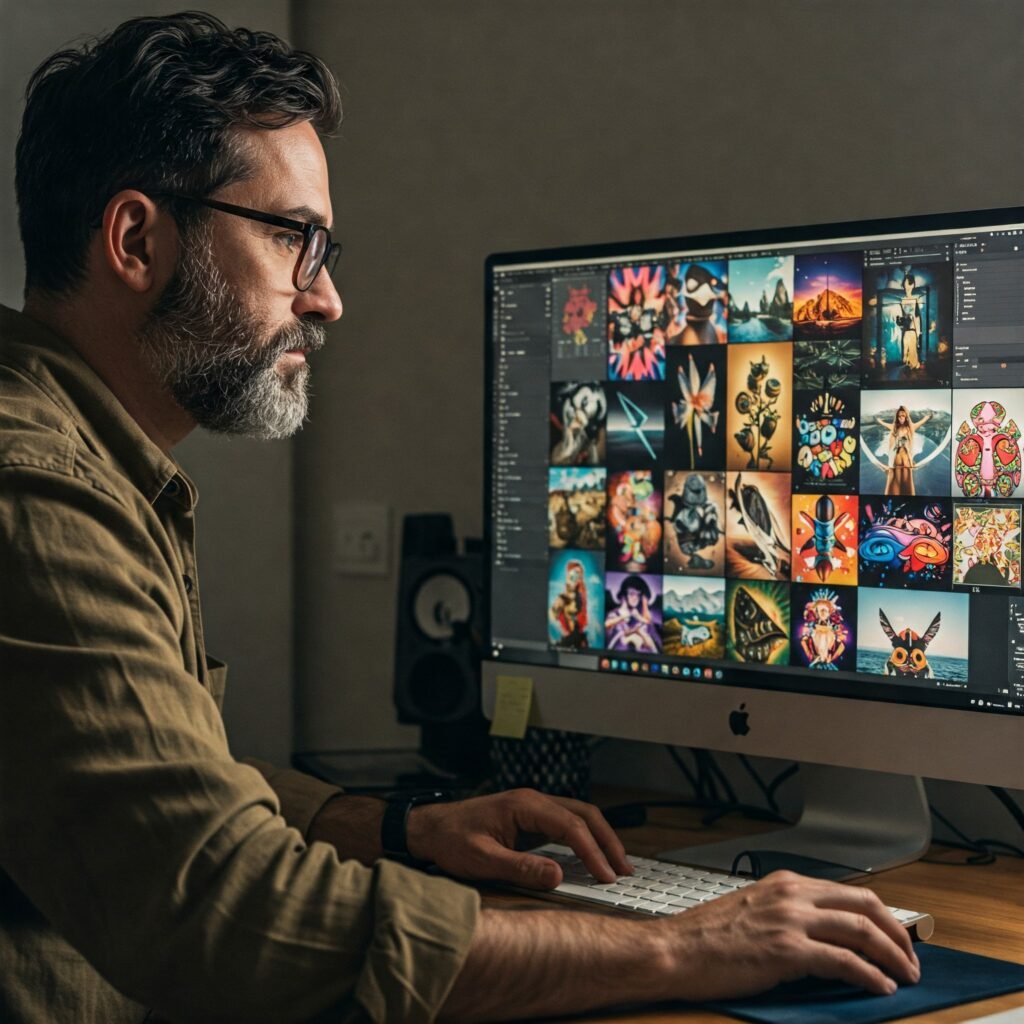In today’s visually saturated digital environment, the ability to create, manage, and optimize digital images is a non-negotiable skill. Whether you’re a marketing professional crafting compelling social media graphics, a web developer ensuring optimal website image size, or a content creator seeking to enhance your visual storytelling, TheTechTarget.com is here to equip you with the knowledge and tools you need.
This expanded guide delves deeper into the intricacies of graphic design, content creation, and image solutions, covering everything from fundamental principles to advanced techniques. We’ll explore the best design tools and image editing software, demystify image metadata, and provide actionable tips for achieving optimal image quality and performance.
Building a Strong Visual Foundation: Graphic Design and Content Creation in Detail
Content creation that resonates with audiences begins with a solid understanding of graphic design principles. Visuals are the cornerstone of effective communication, and mastering the art of visual storytelling is paramount.
Layout Design: Beyond the Basics:
- Understanding the Grid System: Explore how grid systems provide structure and consistency to your designs. Learn how to create and implement grid layouts for various applications.
- Typography: Dive deeper into the world of typography. Understand the nuances of font selection, pairing, and hierarchy. Explore how to use typography to convey specific emotions and messages.
- Color Theory: Explore advanced color theory concepts, such as color harmonies, psychological impacts of color, and the use of color palettes.
- Practical Example: When designing a website landing page, use a grid system to align text and images, choose a font that reflects your brand’s personality, and select a color palette that evokes trust and professionalism.
- For more specific tips, see our article on Advanced Layout Techniques for Web Design.
Social Media Design: Tailoring Visuals for Engagement:
- Platform-Specific Considerations: Understand the unique visual requirements of each social media platform. Explore how to optimize images for Instagram, Facebook, Twitter, LinkedIn, and other platforms.
- Creating Engaging Visual Content: Learn how to create visually appealing content that captures attention and drives engagement. Explore techniques such as using eye-catching visuals, adding text overlays, and creating animated content.
- Social media images must be optimized for loading speed as well, even if the platform does some compression.
- Practical Example: For Instagram, create visually consistent stories using a branded color palette and typography. Use high-quality images and videos to capture attention and encourage engagement.
- See our detailed guide on Optimizing Social Media Images for Every Platform.

Design Innovation: Staying Ahead of the Curve:
- Emerging Trends: Stay updated on the latest trends in design, such as motion graphics, 3D design, and augmented reality.
- Exploring New Tools and Techniques: Explore emerging design tools and techniques, such as AI-powered design tools and collaborative design platforms.
- Learn about accessibility standards for images, like alt text implementation.
- Practical Example: Experiment with AI-powered design tools to generate unique visual concepts and automate repetitive tasks.
- Keep up with new tools in our Design Innovation News and Reviews section.
Mastering Image Manipulation: Creation and Processing
Digital images offer a wealth of creative possibilities. Mastering the art of image manipulation can unlock new levels of visual expression.
GIF Images: Adding Motion and Personality:
- Creating Animated GIFs: Explore various tools and techniques for creating animated GIFs, such as using video editing software and online GIF makers.
- Optimizing GIFs for Performance: Learn how to optimize GIFs for web use, ensuring they load quickly and smoothly.
- Practical Example: Create animated GIFs to showcase product demonstrations, create engaging social media posts, or add visual interest to your website.
Image Processing: Enhancing and Transforming Images:
- Advanced Editing Techniques: Explore advanced image editing techniques, such as frequency separation, dodge and burn, and color grading.
- Image Restoration and Retouching: Learn how to restore damaged images and retouch photos to enhance their appearance.
- Practical Example: Use frequency separation to smooth skin texture in portraits or use color grading to create a cinematic look for your photos.
- Learn more in our guide on Advanced Photo Editing Techniques for Stunning Visuals.
Photo Editing Techniques: A Deeper Dive:
- Layer-Based Editing: Master the art of layer-based editing, which allows for non-destructive image manipulation.
- Masking and Selection: Learn how to use masking and selection tools to isolate specific areas of an image.
- Use of adjustment layers for non destructive editing.
- Practical Example: Use layer masks to create complex composites or use selection tools to isolate objects for editing.
Choosing the Right Tools: Design Tools and Image Editing Software
Selecting the appropriate design tools and image editing software is crucial for achieving your creative goals.
Image Editing Software: A Comprehensive Overview:
- Professional-Grade Software: Explore professional-grade image editing software, such as Adobe Photoshop, Affinity Photo, and Capture One.
- User-Friendly Options: Explore user-friendly image editing software, such as Canva, Pixlr, and Fotor.
- Mobile Editing: Mention mobile image editing apps, and their growing capabilities.
- Practical Example: If you’re a professional photographer, consider using Adobe Photoshop or Capture One for their advanced editing capabilities. If you’re a beginner, consider using Canva or Pixlr for their user-friendly interfaces.

Free Image Editor: Accessible Editing Solutions:
- Exploring Free Alternatives: Explore free image editing software, such as GIMP, Photopea, and Krita.
- Feature Comparison: Compare the features and capabilities of various free image editing software.
- Practical Example: Use GIMP for advanced image editing tasks or Photopea for quick online edits.
Online Community: Collaboration and Inspiration:
- Engaging with Design Communities: Explore online design communities, such as Behance, Dribbble, and Reddit’s r/design.
- Learning from Other Designers: Learn from other designers by exploring their work, participating in discussions, and seeking feedback.
- Practical Example: Join online design communities to get feedback on your work, discover new design trends, and connect with other designers.
Optimizing Images for the Web and Beyond: Size, Quality, and Performance
Optimizing images for various platforms is essential for delivering a seamless user experience.
Website Image Size: Ensuring Optimal Performance:
Image Compression Techniques: Explore various image compression techniques, such as lossy and lossless compression.
Responsive Image Optimization: Learn how to optimize images for responsive websites, ensuring they display correctly on various devices.
Practical Example: Use image compression tools to reduce the file size of your website images without sacrificing quality. Implement responsive image techniques to ensure your images display correctly on mobile devices.
We have a detailed guide on How to Optimize Images for SEO.
Resize Image Online and Free Image Resizer: Quick and Easy Solutions:
- Exploring Online Tools: Explore various online image resizing and compression tools.
- Batch Processing: Learn how to batch process images to resize and compress multiple images at once.
- Practical Example: Use online image resizing tools to quickly adjust the dimensions of your social media images.
Change Image Dimensions and Compress Image Size: Precision and Efficiency:
Understanding Image Resolution: Understand the relationship between image resolution and file size.
Using Image Editing Software: Learn how to use image editing software to resize and compress images.
Practical Example: Use image editing software to resize and compress images for print or web use.
Reduce Photo Size and Improve Image Quality: Balancing Performance and Aesthetics:
Image Optimization for Various Platforms: Learn how to optimize images for various platforms, such as social media, websites, and print.
Techniques for Enhancing Image Quality: Explore techniques for enhancing image quality, such as sharpening, noise reduction, and color correction.
Practical Example: Use image optimization techniques to ensure your images look their best on social media.
Also, you can check our tool TheTechTarget Image Compressor for easy image compression.
Image Size Checker: Ensuring Compliance:
Why and when to use these tools: Understand the importance of using image size checkers to ensure images meet platform-specific requirements and maintain optimal website performance.
Practical Example: Use an image size checker before uploading images to a website or social media platform to avoid performance issues.
Utilize an image size checker tool to ensure your images meet the required specifications.
Image Metadata and File Formats: The Foundation of Image Management
Understanding image metadata and image file formats is crucial for organizing and managing your image library.
Image Metadata: Unlocking Image Information:
- Understanding Metadata Fields: Explore various metadata fields, such as EXIF data, IPTC data, and XMP data.
- Metadata Management Tools: Explore metadata management tools, such as Adobe Bridge and ExifTool.
- Practical Example: Use metadata to tag and categorize your images, making them easier to find and manage.
- Learn how to properly add image metadata for better image management.
Image File Formats: Choosing the Right Format:
- Comparing File Formats: Compare the features and capabilities of various image file formats, such as JPEG, PNG, GIF, TIFF, and WebP.
- WebP and AVIF information: Understand the advantages of modern image formats like WebP and AVIF for web use.
- Practical Example: Use JPEG for photographs, PNG for graphics with transparency, and WebP for web images to optimize website loading speeds.
Practical Tips and Techniques for Enhanced Image Management
Photo Editing Tips:
- Adjust brightness and contrast to enhance the overall look of your images.
- Use the crop tool to remove unwanted elements and improve composition.
- Experiment with filters and effects to create unique visuals.
- Learn how to use layers to create complex edits.
- Practice regularly to refine your skills.
- Learn practical photo editing techniques from our expert tutorials.
Social Media Graphics:
- Use high-resolution images to ensure crisp and clear visuals.
- Optimize images for each platform’s specific requirements.
- Use consistent branding to create a cohesive visual identity.
- Use compelling visuals to capture attention and drive engagement.
- Use social media graphics that are designed for each platforms specifications.
Image Management:
- Organize your images into folders and use descriptive filenames.
- Use metadata to tag and categorize your images.
- Back up your images regularly to prevent data loss.
- Utilize cloud storage for easy access and sharing.
- Learn best practices for image management to keep your files organized.
The TechTarget.com Advantage: Your Partner in Digital Image Mastery
At TheTechTarget.com, we understand the importance of image solutions in today’s digital landscape. We provide a wealth of resources, including tutorials, reviews, and guides, to help you master the art of digital image creation and optimization.
- Explore our comprehensive reviews of image editing software and design tools. [Link to existing tool review category or specific tool review].
- Learn practical photo editing techniques from our expert tutorials.
- Stay updated on the latest trends in design innovation and image processing.
- We have a detailed guide on How to Optimize Images for SEO.
- Also, you can check our tool TheTechTarget Image Compressor for easy image compression.
- Find more information on how to improve image quality.
Conclusion
Mastering digital images is an ongoing process. By understanding the fundamentals of graphic design, utilizing the right design tools, and optimizing your images for various platforms, you can create visually compelling content that resonates with your audience.
Whether you’re looking to resize image online, improve image quality, learn advanced photo editing techniques, or simply understand image file formats, TheTechTarget.com is your go-to resource for all things digital images. Embrace the power of visuals and unlock your creative potential.






